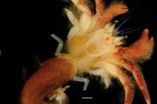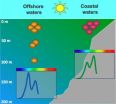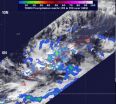(Press-News.org) ITHACA, N.Y. – Are juicier, sweeter, more disease-resistant watermelons on the way? An international consortium of more than 60 scientists from the United States, China, and Europe has published the genome sequence of watermelon (Citrullus lanatus) — information that could dramatically accelerate watermelon breeding toward production of a more nutritious, tastier and more resistant fruit. The watermelon genome sequence was published in the Nov. 25 online version of the journal Nature Genetics.
The researchers discovered that a large portion of disease resistance genes were lost in the domestication of watermelon. With the high-quality watermelon sequence now complete, it is hoped that breeders can now use the information to recover some of these natural disease defenses.
The authors reported that the genome of the domesticated watermelon contained 23,440 genes, roughly the same number of genes as in humans. The group compared the genomes of 20 different watermelons and developed a first-generation genetic variation map for watermelon. This information allowed them to identify genomic regions that have been under human selection, including those associated with fruit color, taste and size.
"Watermelons are an important cash crop and among the top five most consumed fresh fruits; however, cultivated watermelons have a very narrow genetic base, which presents a major bottleneck to its breeding. Decoding the complete genome of the watermelon and resequencing watermelons from different subspecies provided a wealth of information and toolkits to facilitate research and breeding," said Zhangjun Fei, a scientist at the Boyce Thompson Institute for Plant Research at Cornell University, and one of the leaders of this project.
Fei worked with BTI scientists on different aspects of the research, including James Giovannoni, to generate the gene expression data through RNA-sequencing and Lukas Mueller to provide additional analysis to confirm the quality of the genome assembly. Fei also collaborated with Amnon Levi, a research geneticist at the USDA-ARS, U.S. Vegetable Laboratory, Charleston, S.C., on genetic mapping and identifying candidate genes that might be useful to enhance disease resistance in watermelon. The genome sequences of the watermelon are publicly available at the Cucurbit Genomics Database, which is created and maintained by Fei's group.
Believed to have originated in Africa, watermelons were cultivated by Egyptians more than 4,000 years ago, where the fruit was a source of water in dry, desert conditions. They are now consumed throughout the world – with over 400 varieties in global commercial production. China leads in global production of the fruit, and the United States ranks fourth with more than 40 states involved in the industry. Despite being over 90 percent water, watermelons do contain important nutrients such as vitamins A and C, and lycopene, a compound that gives some fruits and vegetables their red color and appears to reduce the risk of certain types of cancer. Watermelon is also a natural source of citrulline, a non-essential amino acid with various health and athletic performance benefits.
INFORMATION:
END
DURHAM, N.C. -- One tropical lizard's tolerance to cold is stiffer than scientists had suspected.
A new study shows that the Puerto Rican lizard Anolis cristatellus has adapted to the cooler winters of Miami. The results also suggest that this lizard may be able to tolerate temperature variations caused by climate change.
"We are not saying that climate change is not a problem for lizards. It is a major problem. However, these findings indicate that the thermal physiology of tropical lizards is more easily altered than previously proposed," said Duke biologist Manuel ...
HOUSTON - Researchers at The University of Texas MD Anderson Cancer Center have tracked down a cancer-promoting protein's pathway into the cell nucleus and discovered how, once there, it fires up a glucose metabolism pathway on which brain tumors thrive.
They also found a vital spot along the protein's journey that can be attacked with a type of drug not yet deployed against glioblastoma multiforme, the most common and lethal form of brain cancer. Published online by Nature Cell Biology, the paper further illuminates the importance of pyruvate kinase M2 (PKM2) in cancer ...
Areopaguristes tudgei. That's the name of a new species of hermit crab recently discovered on the barrier reef off the coast of Belize by Christopher Tudge, a biology professor at American University in Washington, D.C.
Tudge has been interested in biology his whole life, from boyhood trips to the beach collecting crustaceans in his native Australia, to his undergraduate and PhD work in zoology and biology at the University of Queensland. He has collected specimens all over the world, from Australia to Europe to North and South America.
Until now, he has never had ...
Athens, Ga. – More people are better off thanks to the impact of an influx of direct-to-consumer advertising spending than they would be without those marketing efforts, according to a study recently published by Jayani Jayawardhana, an assistant professor in the University of Georgia College of Public Health.
The multi-year study focused on advertising efforts surrounding cholesterol-reducing prescription medications. Jayawardhana found increased levels of consumer welfare due to direct-to-consumer advertising than when compared to situations without this type of marketing. ...
Call it "PAC-MAN, the Sequel." Scientists with NASA's Cassini mission have spotted a second feature shaped like the 1980s video game icon in the Saturn system, this time on the moon Tethys.
The pattern appears in thermal data obtained by Cassini's composite infrared spectrometer, with warmer areas making up the PAC-MAN shape.
"Finding a second PAC-MAN in the Saturn system tells us that the processes creating these 'PAC-MEN' are more widespread than previously thought," said Dr. Carly Howett, the lead author of a recently published paper in the journal Icarus. "The Saturn ...
An international team of biologists led by Indiana University's David M. Kehoe has identified both the enzyme and molecular mechanism critical for controlling a chameleon-like process that allows one of the world's most abundant ocean phytoplankton, once known as blue-green algae, to maximize light harvesting for photosynthesis.
Responsible for contributing about 20 percent of the total oxygen production on the planet, the cyanobacteria Synechococcus uses its own unique form of a sophisticated response called chromatic acclimation to fine tune the absorption properties ...
Implementation of the Affordable Care Act – now assured by the re-election of President Obama – is expected to result in up to 50 million currently uninsured Americans acquiring some type of health insurance coverage. But a study by researchers at the Mongan Institute for Health Policy at Massachusetts General Hospital (MGH) finds that a significant percentage of the primary care physicians most likely to care for newly insured patients may be not be accepting new patients. The investigators note that strategies designed to increase and support these "safety-net" physicians ...
Shedding light on the limits of life in extreme environments, scientists have discovered abundant and diverse metabolically active bacteria in the brine of an Antarctic lake sealed under more than 65 feet of ice.
The finding, described in this week's issue of the Proceedings of the National Academy of Sciences, is surprising because previous studies indicate that the brine has been isolated from the surface environment -- and external sources of energy -- for at least 2,800 years, according to two of the report's authors, Peter Doran and Fabien Kenig, both professors ...
You could call this "Pac-Man, the Sequel." Scientists with NASA's Cassini mission have spotted a second feature shaped like the 1980s video game icon in the Saturn system, this time on the moon Tethys. (The first was found on Mimas in 2010). The pattern appears in thermal data obtained by Cassini's composite infrared spectrometer, with warmer areas making up the Pac-Man shape.
"Finding a second Pac-Man in the Saturn system tells us that the processes creating these Pac-Men are more widespread than previously thought," said Carly Howett, the lead author of a paper recently ...
The twenty-sixth tropical cyclone of the western North Pacific Ocean season formed and has some areas of heavy rain, according to data from NASA's TRMM satellite. Tropical Depression 26W is threatening islands within Micronesia and warnings and watches are currently in effect.
Micronesia is a region in the western North Pacific Ocean made up of thousands of small islands. West of the region is the Philippines, while Indonesia is located to the southwest.
NASA's Tropical Rainfall Measuring Mission (TRMM) satellite passed over Tropical Depression 26W on Nov. 26 at 0526 ...




